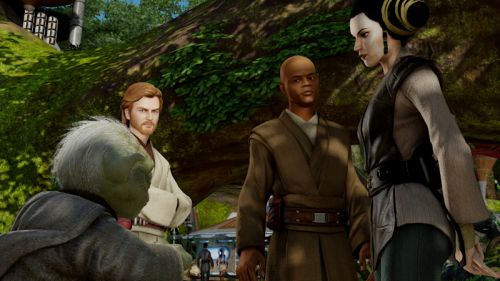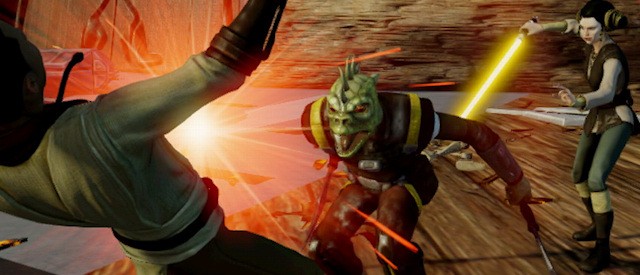Kinect Star Wars, like the two Disney Kinect games before it, combines multiple elements of the Star Wars franchise into one game rather than focusing on a single movie or narrative. It draws most liberally from the Clone Wars period and is aimed at a younger audience, like most Kinect software. But characters and scenes from the originally trilogy pop up as well and will make older fans either smile or wince with disapproval, depending on their mindset. Not everyone will love Kinect Star Wars – you have to enjoy Kinect games (I believe many reviewers don’t) and approach it with a sense of humor and whimsy. If you lack those things, at least try to fake it for the duration of my review.
The premise of the game is that C3PO and R2-D2 need help sorting through the recently-discovered Jedi archives. The two lovable droids act as your companions while you navigate the menus and select from a variety of game modes. The menus are very good for a Kinect game, though scrolling left and right is slower than necessary. You can also navigate 90 percent of them with voice commands – the most of any Kinect game I’ve played. Why they forgot to enable voice in the pause menu and a couple of other places, I’ll never know, but other games do it worse.
Kinect Star Wars offers five different game modes of varying length and complexity. Jedi Destiny, the actual campaign, casts players as Jedi apprentices caught up in a battle good and evil. The story is cinematic and fully-voice acted. Everyone does a great job, with the exception of Yoda, Mace Windu, and Obi Wan, who all sound terrible. Throughout the adventure, players get to ride along on a variety of vehicles, manning the turret of a Millennium Falcon-like ship amid a huge space battle, fending off speeder bikes on the forest planet of Kashyyyk, and lots more. You’ll also spend plenty of time on foot, taking down Battle Droids and various alien menaces. It’s an authentic, serious Star Wars experience.

"Listen to the real Yoda's voice before recording my lines, I did not."
Let’s talk about the ground controls. Your right hand swings and blocks with your lightsaber while the left hand is used to control the force. Most enemies are immune to force attacks, but many scripted moments come up when you can throw droids into each other, toss bombs onto giant spider-like tanks (ala The Empire Strikes Back), lift huge objects, and more. To walk forward, you just thrust out your right leg; I found this easier and less strenuous than running in place ala Kinect Rush. Finally, actually jumping causes the player’s Jedi to leap over crevices or enemies.
Some people criticize the ground sections for being on rails, a term which brings negative inexplicably negative connotations. True, you don’t get to walk around wherever you like, instead rushing from fight to fight, and hazard to hazard. But I grew up in an era of beat-em-ups, and Jedi Destiny works much the same way. Besides, the on-foot navigation in Kinect Disneyland Adventures and Kinect Rush is not exactly intuitive. Jedi Destiny puts the hassle of wandering around aside and keeps players focused on the cinematic adventure at hand.
Like the beat-em-ups of yore, Jedi Destiny is fully co-op. The second player can select a character at the beginning or simply drop in or out at any time. The game switches to split-screen for co-op. Sometimes both players have challenges that they must overcome independently (such as each of you dueling against a different Sith). If one person finishes first, he or she gets a “Waiting for other player” message until the other one completes the task. That minor inconvenience aside, my partner and I had a blast stepping into the shoes of young Jedis together.
